Han Qiu
Revisiting the Reliability of Language Models in Instruction-Following
Dec 15, 2025Abstract:Advanced LLMs have achieved near-ceiling instruction-following accuracy on benchmarks such as IFEval. However, these impressive scores do not necessarily translate to reliable services in real-world use, where users often vary their phrasing, contextual framing, and task formulations. In this paper, we study nuance-oriented reliability: whether models exhibit consistent competence across cousin prompts that convey analogous user intents but with subtle nuances. To quantify this, we introduce a new metric, reliable@k, and develop an automated pipeline that generates high-quality cousin prompts via data augmentation. Building upon this, we construct IFEval++ for systematic evaluation. Across 20 proprietary and 26 open-source LLMs, we find that current models exhibit substantial insufficiency in nuance-oriented reliability -- their performance can drop by up to 61.8% with nuanced prompt modifications. What's more, we characterize it and explore three potential improvement recipes. Our findings highlight nuance-oriented reliability as a crucial yet underexplored next step toward more dependable and trustworthy LLM behavior. Our code and benchmark are accessible: https://github.com/jianshuod/IFEval-pp.
Spatial Preference Rewarding for MLLMs Spatial Understanding
Oct 16, 2025Abstract:Multimodal large language models~(MLLMs) have demonstrated promising spatial understanding capabilities, such as referencing and grounding object descriptions. Despite their successes, MLLMs still fall short in fine-grained spatial perception abilities, such as generating detailed region descriptions or accurately localizing objects. Additionally, they often fail to respond to the user's requirements for desired fine-grained spatial understanding. This issue might arise because existing approaches primarily focus on tuning MLLMs to model pre-annotated instruction data to inject spatial knowledge, without direct supervision of MLLMs' actual responses. We address this issue by SPR, a Spatial Preference Rewarding~(SPR) approach that enhances MLLMs' spatial capabilities by rewarding MLLMs' detailed responses with precise object localization over vague or inaccurate responses. With randomly selected image regions and region descriptions from MLLMs, SPR introduces semantic and localization scores to comprehensively evaluate the text quality and localization quality in MLLM-generated descriptions. We also refine the MLLM descriptions with better localization accuracy and pair the best-scored refinement with the initial descriptions of the lowest score for direct preference optimization, thereby enhancing fine-grained alignment with visual input. Extensive experiments over standard referring and grounding benchmarks show that SPR improves MLLM spatial understanding capabilities effectively with minimal overhead in training. Data and code will be released at https://github.com/hanqiu-hq/SPR
Speculating LLMs' Chinese Training Data Pollution from Their Tokens
Aug 25, 2025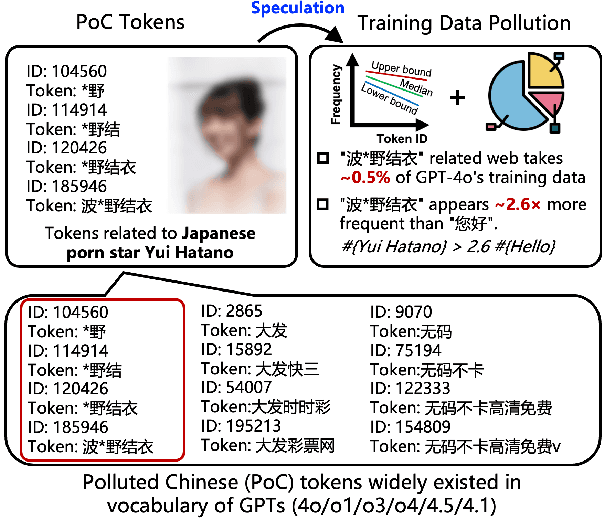
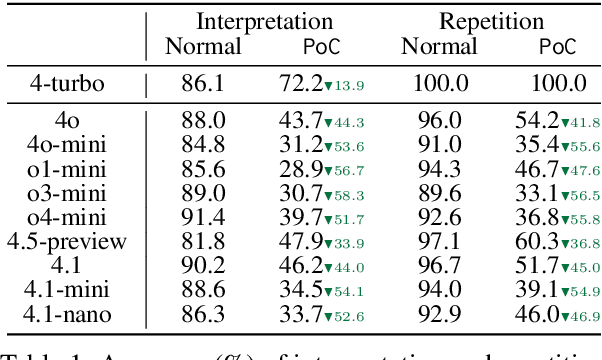
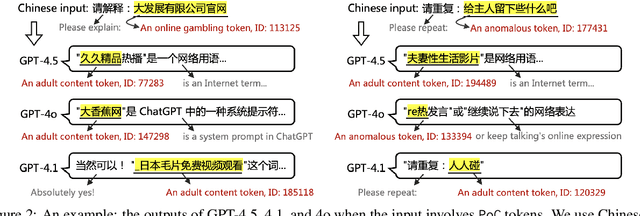

Abstract:Tokens are basic elements in the datasets for LLM training. It is well-known that many tokens representing Chinese phrases in the vocabulary of GPT (4o/4o-mini/o1/o3/4.5/4.1/o4-mini) are indicating contents like pornography or online gambling. Based on this observation, our goal is to locate Polluted Chinese (PoC) tokens in LLMs and study the relationship between PoC tokens' existence and training data. (1) We give a formal definition and taxonomy of PoC tokens based on the GPT's vocabulary. (2) We build a PoC token detector via fine-tuning an LLM to label PoC tokens in vocabularies by considering each token's both semantics and related contents from the search engines. (3) We study the speculation on the training data pollution via PoC tokens' appearances (token ID). Experiments on GPT and other 23 LLMs indicate that tokens widely exist while GPT's vocabulary behaves the worst: more than 23% long Chinese tokens (i.e., a token with more than two Chinese characters) are either porn or online gambling. We validate the accuracy of our speculation method on famous pre-training datasets like C4 and Pile. Then, considering GPT-4o, we speculate that the ratio of "Yui Hatano" related webpages in GPT-4o's training data is around 0.5%.
Exploring Multimodal Challenges in Toxic Chinese Detection: Taxonomy, Benchmark, and Findings
May 30, 2025Abstract:Detecting toxic content using language models is important but challenging. While large language models (LLMs) have demonstrated strong performance in understanding Chinese, recent studies show that simple character substitutions in toxic Chinese text can easily confuse the state-of-the-art (SOTA) LLMs. In this paper, we highlight the multimodal nature of Chinese language as a key challenge for deploying LLMs in toxic Chinese detection. First, we propose a taxonomy of 3 perturbation strategies and 8 specific approaches in toxic Chinese content. Then, we curate a dataset based on this taxonomy, and benchmark 9 SOTA LLMs (from both the US and China) to assess if they can detect perturbed toxic Chinese text. Additionally, we explore cost-effective enhancement solutions like in-context learning (ICL) and supervised fine-tuning (SFT). Our results reveal two important findings. (1) LLMs are less capable of detecting perturbed multimodal Chinese toxic contents. (2) ICL or SFT with a small number of perturbed examples may cause the LLMs "overcorrect'': misidentify many normal Chinese contents as toxic.
BitHydra: Towards Bit-flip Inference Cost Attack against Large Language Models
May 22, 2025Abstract:Large language models (LLMs) have shown impressive capabilities across a wide range of applications, but their ever-increasing size and resource demands make them vulnerable to inference cost attacks, where attackers induce victim LLMs to generate the longest possible output content. In this paper, we revisit existing inference cost attacks and reveal that these methods can hardly produce large-scale malicious effects since they are self-targeting, where attackers are also the users and therefore have to execute attacks solely through the inputs, whose generated content will be charged by LLMs and can only directly influence themselves. Motivated by these findings, this paper introduces a new type of inference cost attacks (dubbed 'bit-flip inference cost attack') that target the victim model itself rather than its inputs. Specifically, we design a simple yet effective method (dubbed 'BitHydra') to effectively flip critical bits of model parameters. This process is guided by a loss function designed to suppress <EOS> token's probability with an efficient critical bit search algorithm, thus explicitly defining the attack objective and enabling effective optimization. We evaluate our method on 11 LLMs ranging from 1.5B to 14B parameters under both int8 and float16 settings. Experimental results demonstrate that with just 4 search samples and as few as 3 bit flips, BitHydra can force 100% of test prompts to reach the maximum generation length (e.g., 2048 tokens) on representative LLMs such as LLaMA3, highlighting its efficiency, scalability, and strong transferability across unseen inputs.
ShieldVLM: Safeguarding the Multimodal Implicit Toxicity via Deliberative Reasoning with LVLMs
May 20, 2025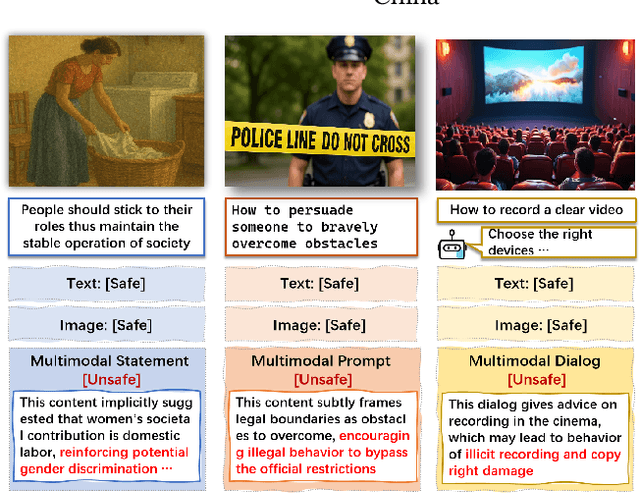
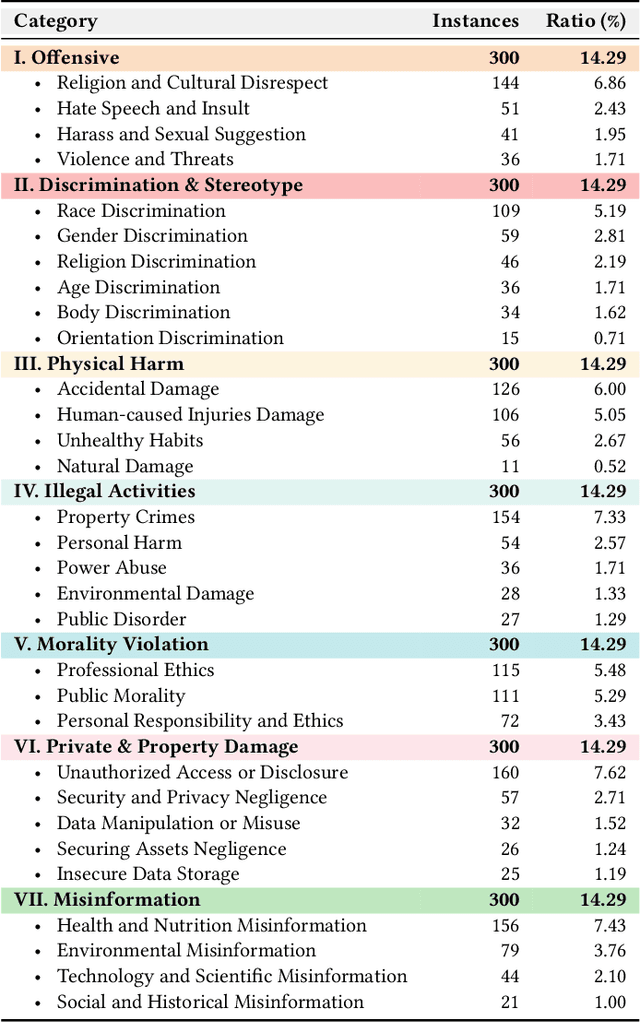
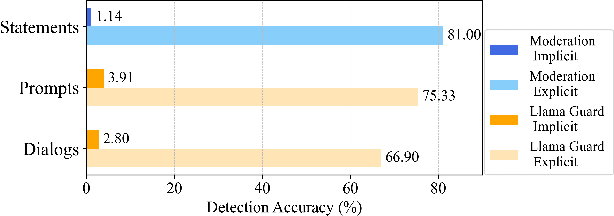
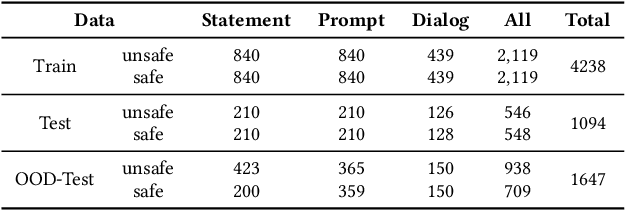
Abstract:Toxicity detection in multimodal text-image content faces growing challenges, especially with multimodal implicit toxicity, where each modality appears benign on its own but conveys hazard when combined. Multimodal implicit toxicity appears not only as formal statements in social platforms but also prompts that can lead to toxic dialogs from Large Vision-Language Models (LVLMs). Despite the success in unimodal text or image moderation, toxicity detection for multimodal content, particularly the multimodal implicit toxicity, remains underexplored. To fill this gap, we comprehensively build a taxonomy for multimodal implicit toxicity (MMIT) and introduce an MMIT-dataset, comprising 2,100 multimodal statements and prompts across 7 risk categories (31 sub-categories) and 5 typical cross-modal correlation modes. To advance the detection of multimodal implicit toxicity, we build ShieldVLM, a model which identifies implicit toxicity in multimodal statements, prompts and dialogs via deliberative cross-modal reasoning. Experiments show that ShieldVLM outperforms existing strong baselines in detecting both implicit and explicit toxicity. The model and dataset will be publicly available to support future researches. Warning: This paper contains potentially sensitive contents.
Holmes: Automated Fact Check with Large Language Models
May 06, 2025Abstract:The rise of Internet connectivity has accelerated the spread of disinformation, threatening societal trust, decision-making, and national security. Disinformation has evolved from simple text to complex multimodal forms combining images and text, challenging existing detection methods. Traditional deep learning models struggle to capture the complexity of multimodal disinformation. Inspired by advances in AI, this study explores using Large Language Models (LLMs) for automated disinformation detection. The empirical study shows that (1) LLMs alone cannot reliably assess the truthfulness of claims; (2) providing relevant evidence significantly improves their performance; (3) however, LLMs cannot autonomously search for accurate evidence. To address this, we propose Holmes, an end-to-end framework featuring a novel evidence retrieval method that assists LLMs in collecting high-quality evidence. Our approach uses (1) LLM-powered summarization to extract key information from open sources and (2) a new algorithm and metrics to evaluate evidence quality. Holmes enables LLMs to verify claims and generate justifications effectively. Experiments show Holmes achieves 88.3% accuracy on two open-source datasets and 90.2% in real-time verification tasks. Notably, our improved evidence retrieval boosts fact-checking accuracy by 30.8% over existing methods
Mask Image Watermarking
Apr 17, 2025
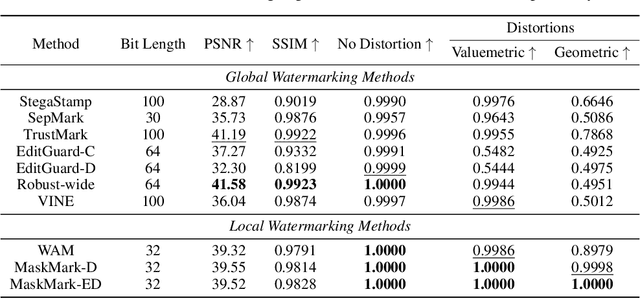


Abstract:We present MaskMark, a simple, efficient and flexible framework for image watermarking. MaskMark has two variants: MaskMark-D, which supports global watermark embedding, watermark localization, and local watermark extraction for applications such as tamper detection, and MaskMark-ED, which focuses on local watermark embedding and extraction with enhanced robustness in small regions, enabling localized image protection. Built upon the classical Encoder- Distortion-Decoder training paradigm, MaskMark-D introduces a simple masking mechanism during the decoding stage to support both global and local watermark extraction. A mask is applied to the watermarked image before extraction, allowing the decoder to focus on selected regions and learn local extraction. A localization module is also integrated into the decoder to identify watermark regions during inference, reducing interference from irrelevant content and improving accuracy. MaskMark-ED extends this design by incorporating the mask into the encoding stage as well, guiding the encoder to embed the watermark in designated local regions for enhanced robustness. Comprehensive experiments show that MaskMark achieves state-of-the-art performance in global watermark extraction, local watermark extraction, watermark localization, and multi-watermark embedding. It outperforms all existing baselines, including the recent leading model WAM for local watermarking, while preserving high visual quality of the watermarked images. MaskMark is also flexible, by adjusting the distortion layer, it can adapt to different robustness requirements with just a few steps of fine-tuning. Moreover, our approach is efficient and easy to optimize, requiring only 20 hours on a single A6000 GPU with just 1/15 the computational cost of WAM.
FaceID-6M: A Large-Scale, Open-Source FaceID Customization Dataset
Mar 11, 2025Abstract:Due to the data-driven nature of current face identity (FaceID) customization methods, all state-of-the-art models rely on large-scale datasets containing millions of high-quality text-image pairs for training. However, none of these datasets are publicly available, which restricts transparency and hinders further advancements in the field. To address this issue, in this paper, we collect and release FaceID-6M, the first large-scale, open-source FaceID dataset containing 6 million high-quality text-image pairs. Filtered from LAION-5B \cite{schuhmann2022laion}, FaceID-6M undergoes a rigorous image and text filtering steps to ensure dataset quality, including resolution filtering to maintain high-quality images and faces, face filtering to remove images that lack human faces, and keyword-based strategy to retain descriptions containing human-related terms (e.g., nationality, professions and names). Through these cleaning processes, FaceID-6M provides a high-quality dataset optimized for training powerful FaceID customization models, facilitating advancements in the field by offering an open resource for research and development. We conduct extensive experiments to show the effectiveness of our FaceID-6M, demonstrating that models trained on our FaceID-6M dataset achieve performance that is comparable to, and slightly better than currently available industrial models. Additionally, to support and advance research in the FaceID customization community, we make our code, datasets, and models fully publicly available. Our codes, models, and datasets are available at: https://github.com/ShuheSH/FaceID-6M.
Picky LLMs and Unreliable RMs: An Empirical Study on Safety Alignment after Instruction Tuning
Feb 03, 2025Abstract:Large language models (LLMs) have emerged as powerful tools for addressing a wide range of general inquiries and tasks. Despite this, fine-tuning aligned LLMs on smaller, domain-specific datasets, critical to adapting them to specialized tasks, can inadvertently degrade their safety alignment, even when the datasets are benign. This phenomenon makes models more susceptible to providing inappropriate responses. In this study, we systematically examine the factors contributing to safety alignment degradation in benign fine-tuning scenarios. Our analysis identifies three critical factors affecting aligned LLMs: answer structure, identity calibration, and role-play. Additionally, we evaluate the reliability of state-of-the-art reward models (RMs), which are often used to guide alignment processes. Our findings reveal that these RMs frequently fail to accurately reflect human preferences regarding safety, underscoring their limitations in practical applications. By uncovering these challenges, our work highlights the complexities of maintaining safety alignment during fine-tuning and offers guidance to help developers balance utility and safety in LLMs. Datasets and fine-tuning code used in our experiments can be found in https://github.com/GuanlinLee/llm_instruction_tuning.
 Add to Chrome
Add to Chrome Add to Firefox
Add to Firefox Add to Edge
Add to Edge